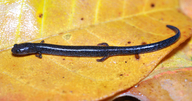|
Oedipina leptopoda McCranie, Vieites & Wake, 2008
Narrow-footed Worm Salamander Subgenus: Oedipina | family: Plethodontidae subfamily: Hemidactyliinae genus: Oedipina |
| Species Description: McCranie JR, Vieites DR, Wake DB 2008 Description of a new divergent lineage and three new species of Honduran salamanders of the genus Oedipina (Caudata, Plethodontidae). Zootaxa 1930:1- 17. | |
 © 2020 Josiah H. Townsend (1 of 3) |
|
|
|
Description Description: The holotype is a subadult female that measures 29.6 mm in SVL; a paratype adult male measures 47.9 mm in SVL. TL of holotype is 62.8 mm, while TL of the paratype is not known as the stout, round tail was broken 44.4 mm from the tail base. The head is broad and rounded, with the subadult holotype having a narrowly rounded snout and the adult male paratype having an expanded, broadly rounded snout. Nostrils are small but prominent. Eyes are moderately sized and extend just beyond lateral margins of the head. Nasolabial protuberances are moderately conspicuous. The suborbital groove does not intersect with the lip line. The premaxillary teeth are located anteriorly, near the front of the mouth and widely separated from the maxillary teeth. Five premaxillary teeth are counted in the holotype, while a single large tooth is present in the adult male paratype. The two specimens also have different numbers of maxillary teeth and vomerine teeth; the young female holotype has 29 maxillary teeth and 10 vomerine teeth, whereas the adult male paratype has 40 maxillary teeth and 17 vomerine teeth. The vomerine teeth are small and are arranged in an arched series. This species has 19 costal grooves between the limbs, with a limb interval of 12. The hands and feet are very narrow, small and flattened. Digits are tightly fused all the way to the tips, defined only by indistinct grooves that suggest borders. The three longest digits of the forelimbs and hindlimbs of the paratype have small, rounded tips, while the longest digit of the holotype is pointed, and extends barely past (less than 0.2 mm) the tips of adjacent digits. The adult male paratype has a small mental gland (McCranie et al. 2008). In preservative, the ground color of the holotype has faded to a moderate brown, and the head and snout are paler than the rest of the body. The paratype has a black ground color, slightly lighter ventrally, with a light gray snout, nasolabial protuberances, and mental gland (McCranie et al. 2008). Distribution and Habitat Country distribution from AmphibiaWeb's database: Honduras
Life History, Abundance, Activity, and Special Behaviors Trends and Threats Possible reasons for amphibian decline General habitat alteration and loss Comments The specific name leptopoda derives from the Greek words for small and foot (McCranie et al. 2008). Previously considered part of O. cyclocauda (Good and Wake 1998; García-París and Wake 2000); Honduran populations are now referred to O. leptopoda while Costa Rican populations are considered to be O. cyclocauda (McCranie et al. 2008). Holotype. MVZ 167772, a subadult female from 32 km (by road) West of Yoro on road to Morazan, 15.267480 N, 87.434820 W, Dept. Yoro, Honduras, collected 8 January 1979 as Oedipina cyclocauda by E. J. Koford and J. F. Lynch. Paratype. MVZ 171078, an adult male from Montana de Yoro, 6.6 km (by road) South of Yoro, 15.073650 N, 87.1333 W, Dept. Yoro, Honduras. Collected in 1978 as Oedipina cyclocauda by J. F. Lynch, E. J. Koford, and E. Balinsky. Referred Specimen. FMNH 34683, subadult, Portillo Grande, Dept. Yoro, Honduras. Collected in 1940 as Oedipina cyclocauda by R. E. Stadelman.
References
Good, D. A., and Wake, D. B. (1997). ''Phylogenetic and taxonomic implications of protein variation in the Mesoamerican salamander genus Oedipina (Caudata: Plethodontidae).'' Revista de Biología Tropical, 45(3), 1185-1208. McCranie, J. R., Vieites, D. R., and Wake, D. B. (2008). ''Description of a new divergent lineage and three new species of Honduran salamanders of the genus Oedipina (Caudata, Plethodontidae).'' Zootaxa, 1930, 1-17. Originally submitted by: Sean B. Reilly and Christine Lu (first posted 2009-10-13) Edited by: Kellie Whittaker (2011-03-10) Species Account Citation: AmphibiaWeb 2011 Oedipina leptopoda: Narrow-footed Worm Salamander <https://amphibiaweb.org/species/7210> University of California, Berkeley, CA, USA. Accessed Jun 16, 2025.
Feedback or comments about this page.
Citation: AmphibiaWeb. 2025. <https://amphibiaweb.org> University of California, Berkeley, CA, USA. Accessed 16 Jun 2025. AmphibiaWeb's policy on data use. |



 Raffaëlli Account
Raffaëlli Account Map of Life
Map of Life